#indian folk art
Text
9 Essential Tips for Buying Art Online
In the digital age, purchasing art online has become a gateway to a world of creative expression. When venturing into the realm of art online, whether you're eyeing a masterpiece or seeking a unique piece like Pichwai Art or Modern Pichwai paintings, these nine essential tips will serve as your compass.
Research and Discover: Explore various art styles and genres to understand what resonates with you. This knowledge will guide your online art journey.
Reputable Platforms: Choose established platforms for buying art online, ones known for curating quality pieces and providing transparent artist information.
Authenticate Artworks: For a satisfying experience, verify the authenticity of the artwork. Look for platforms that provide artist backgrounds and certificates of authenticity.
Examine Details: Dive into the intricacies of the artwork. Zoom in to appreciate textures, brushwork, and hues, and read descriptions for essential details.
Budget Wisely: Set a budget inclusive of potential expenses like shipping. This step will narrow down your options and prevent overspending.
Understand Returns: A clear return policy ensures peace of mind. Familiarize yourself with the terms, especially for returning damaged pieces.
Engage with the Community: Join art communities and forums to glean insights from seasoned collectors, garnering advice and recommendations.
Safe Transactions: Prioritize platforms offering secure payment methods to safeguard your financial information.
Follow Your Instincts: Trust your gut. If a piece speaks to you, it might be the perfect addition to your collection.
When venturing into the world of art online, these tips will equip you to make informed choices, ensuring your collection reflects your unique tastes. For those captivated by the allure of Sachin Sagare's paintings, Durshit Bhaskar's art, Pichwai Art, and Modern Pichwai paintings, platforms like BeyondSquare.in offering a curated selection, infusing tradition with contemporary allure.









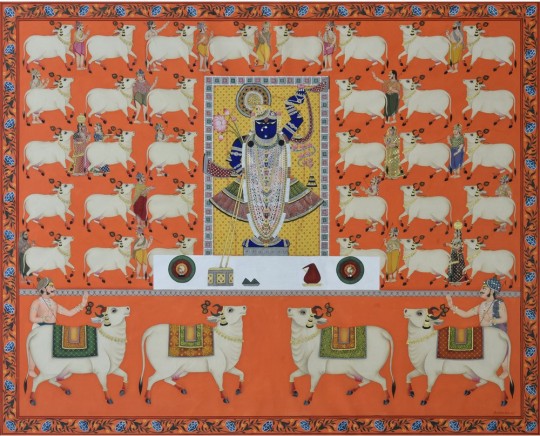

#Modernart#Rajasthani paintings#Indian folk art#Pichwai paintings#Krishna leela paintings#Hindu deity art#Krishna paintings
0 notes
Text
Kalighat painting, an extraordinary style of Indian folk art, originated in the 19th century within the vibrant Kalighat area of Kolkata (formerly Calcutta), West Bengal, India. It emerged during a period of profound social and cultural change in colonial India, and quickly gained popularity as a unique and expressive form of artistic expression.
0 notes
Text
Traditional Indian Art forms – Why are they disappearing?
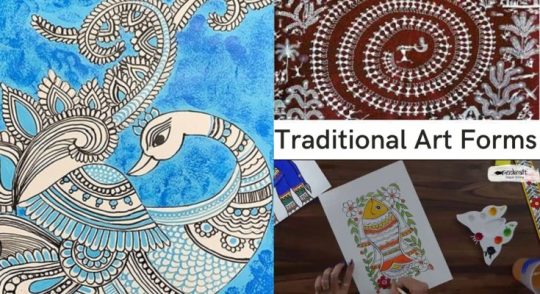
TRADITIONAL INDIAN ART FORMS - WHY ARE THEY DISAPPEARING?
India has an amazing culture and history of different art forms and handicrafts. India is the hometown for more than 50 tribal and traditional folk arts. These folk arts of India have passed from generation to generation from over 3000 years. But lots of these traditions are about to disappear.
Folk art of India is a very respected and very important element of India’s Culture. It has been practiced and perfected by artisans' generations. The reason for disappearing these traditional Indian art forms is complex. There are lots of factors that have resulted in the disappearance of the traditional Indian Art forms.
Two major reasons for the disappearance of Traditional Indian form are westernization and Industrialization. The cultural identity of traditional art form, buyers, artists and beliefs have had a negative effect of westernization. This has changed in what was made for them, what they made, and how it was made. The lack of attention and interest about traditional art forms in current generation art collectors, in India as well as outside has led to disappointing situations where these arts are slowly disappearing.
Now talking about industrialization resulting in creating goods, longer lasting, cheaper and faster to the customers. Government is spending a lot to sustain and motivate the traditional art industry. They even require training in design, processes, products, material expertise and much needed awareness of international trends to come up with creative solutions.
Government’s organizational set up itself has very little scope for satisfactory profit margin for artists and craftsmen. This is discouraging the upcoming generations from ancestral to choose a traditional art form as a profession. New generation is not preferring this profession because of its low earning potential.
Telangana’s Cheriyal scrolls, Karnataka's the chittara, West Bengal’s the Dhokra, Rajasthan’s the Kavad , Andra’s Leather puppet and other art forms all are disappearing. Traditional art forms are all endangered because most of them aren’t making money and customers don’t want to do them. When considering the traditional art forms it includes carving, nirmal painting, wicker woven baskets. Nowadays design trends leaning towards modernism, the demand for traditional items is reducing. China and other Asian markets are now mass producing and supplying trendy natural materials everywhere that is disrupting the market size for artisan and craftsmen.
Traditional art needs to be saved for its original value and not just as an option to earn money. We need new ways to keep traditional arts alive by encouraging those who have passion for art but can’t afford it. The western art is replacing traditional art forms in our living rooms. While the traditional art form has maintained significant identity, It is eventually losing its relevance in the global and domestic art sphere.
By making sure that artisans get the major share of profit, not middle agents will encourage artisans. Consumers' interest in traditional art forms lives when the updated designs, quality, and skill of the craftsman are preferred over quantity and bad workmanship.
India with its diverse and very very rich traditional arts, must focus on the strength of artisans and getting best deals for their craftsmen in the international market by implementing better strategies.
Penkraft conducts classes, course, online courses, live courses, workshops, teachers' training & online teachers' training in Handwriting Improvement, Calligraphy, Abacus Maths, Vedic Maths, Phonics and various Craft & Artforms - Madhubani, Mandala, Warli, Gond, Lippan Art, Kalighat, Kalamkari, Pichwai, Cheriyal, Kerala Mural, Pattachitra, Tanjore Painting, One Stroke Painting, Decoupage, Image Transfer, Resin Art, Fluid Art, Alcohol Ink Art, Pop Art, Knife Painting, Scandinavian Art, Water Colors, Coffee Painting, Pencil Shading, Resin Art Advanced etc. at pan-India locations. With our mission to inspire, educate, empower & uplift people through our endeavours, we have trained & operationally supported (and continue to support) 1500+ home-makers to become Penkraft Certified Teachers? in various disciplines.
1 note
·
View note
Text
After many years of search, found Shri M S Anand Anand, who accepted me as his student to pass on this amazing and endangered folk art of India, Mysore painting. Starting with Saraswati, Goddess of knowledge and art.
Sharing the second step in this process.
#mysore #indianart #indianfolkart #indianartist #saraswati #Mysorepainting
0 notes
Text

#handemade#terracotta#wall art#indian home decor#indian folk art#Handmade Indian folk art wall hanging for Indian home decor.#Please visit mollisarts for many more unique Indian art collectibles and follow us to get update on new Indian Folk art stories.#https://mollisarts.com/shop.php
1 note
·
View note
Link
Indian folk art has had a rich history. Jamini Roy is one of the artists known for working extensively in Indian folk art painting, especially creative indian folk art, indian folk art painting, easy indian folk art, indian folk art drawing and kalamkari indian folk art, folk art painting as he mixed both western and Indian art styles.
0 notes
Text
Warli Art “The Village” Greeting Card Design
Hi Art Lovers,
This is Warli art, it is the traditional art form of Indian State Maharashtra. In ancient times, people used to make this type of art on their pots, utensils, houses before celebrations.
First they use red mud to make a surface, and then use geometric shapes to depict daily village life.
I bring you an original Warli art called The Village on greeting cards. Perfect card for someone close or family.
To get this product on more products, please visit my store: https://rdbl.co/39mLobT
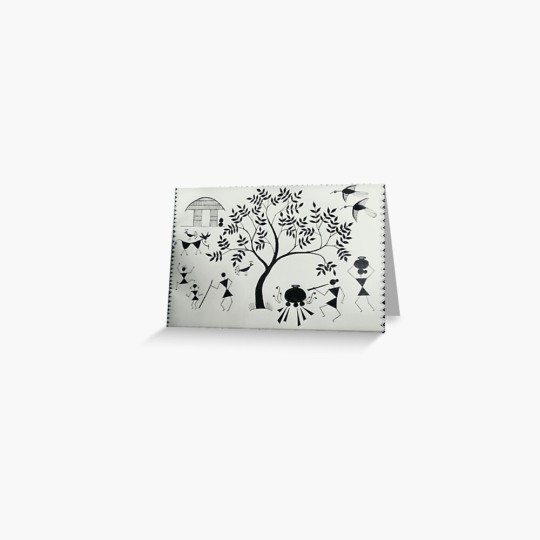
#warli paintings of maharashtra#warli#warli art#greetings#greetingcard#greetingcarddesign#warlidesign#indianart#indian art#indian folk art#tribal art#redbubble#artists on tumblr
1 note
·
View note
Text
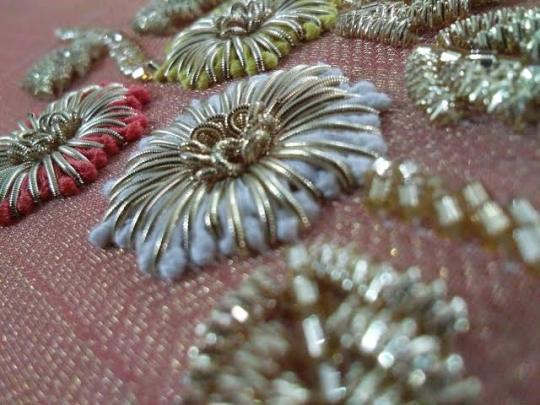
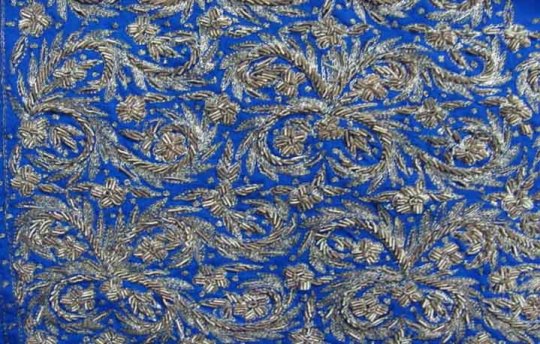

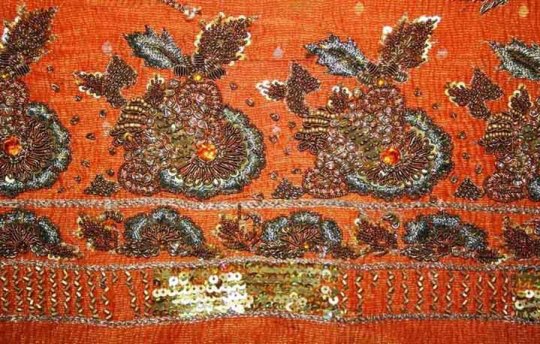

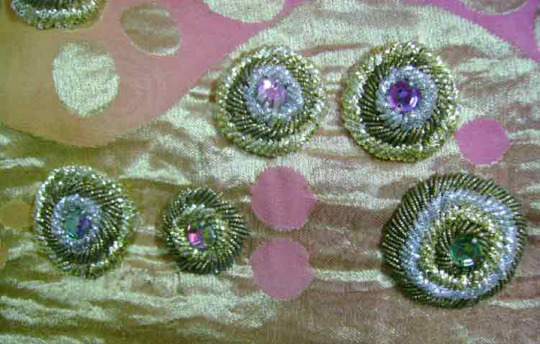
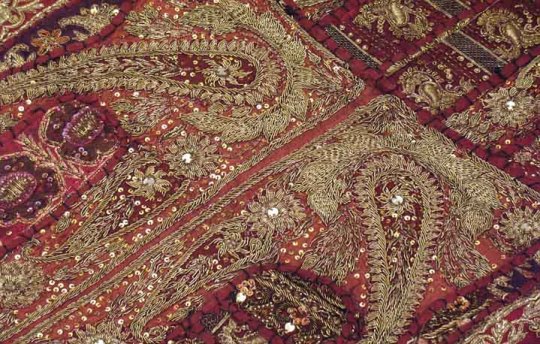
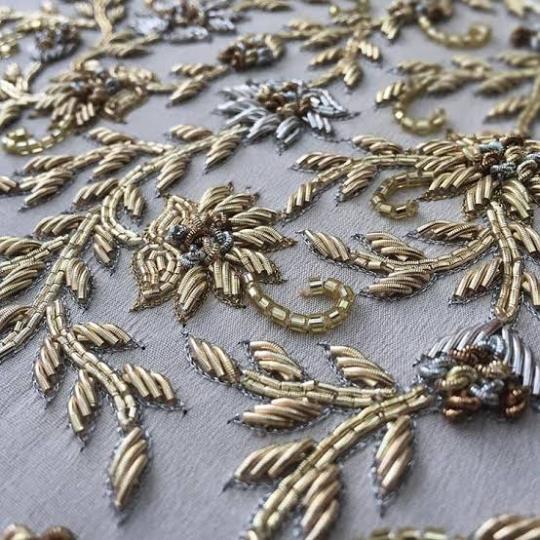

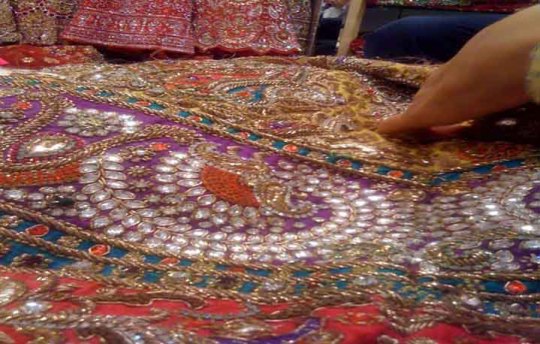
Dabka or Dapka is a detailed type of needlework from Rajasthan in India. It is usually done at the final stage of the production process to add finishing touch embellishments.
At least three to four worker workers are required for a detailed and fine work at the same time on the same piece. First a thick cotton cord is stitched on the pattern to be embroidered. Then on this cord prefabricated metal thread is looped on with an ordinary stitching needle. The patterns mostly made are of flowers, leaves, or birds. Skilled embroiders can even do french knots with the smallest size.
1 / 2 / 3 / 4 / 5 / 6 / 7 / 8 / 9 / 10 / 11 | textile series
#textiles#ots#rajasthan#india#textile art#desi fashion#desi tumblr#desiblr#indian fashion#folk art#textile history
2K notes
·
View notes
Text
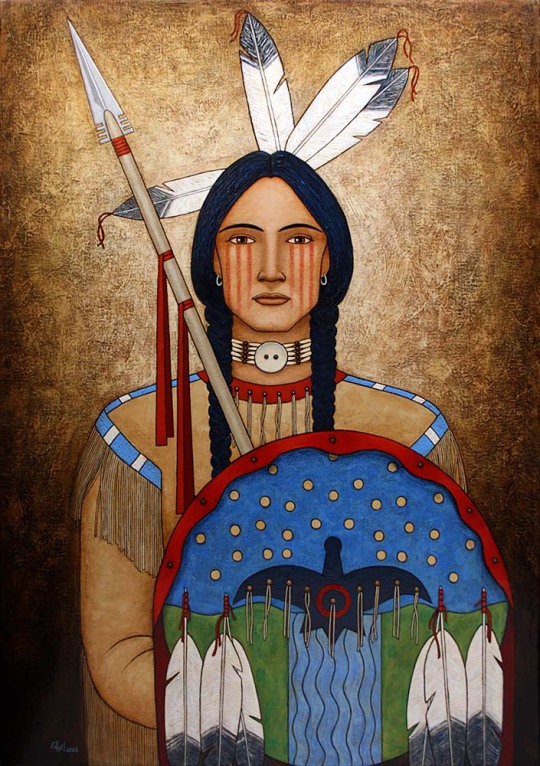
“strong medicine shield”, 2023 by Norman Engel
#contemporary art#contemporary painting#Norman Engel#Texas artist#southwest art#western art#contemporary western art#native american#american indian#folk art#folk art painting#naive art#primitivism#outsider art#modern art#painting#acrylic on canvas
77 notes
·
View notes
Photo
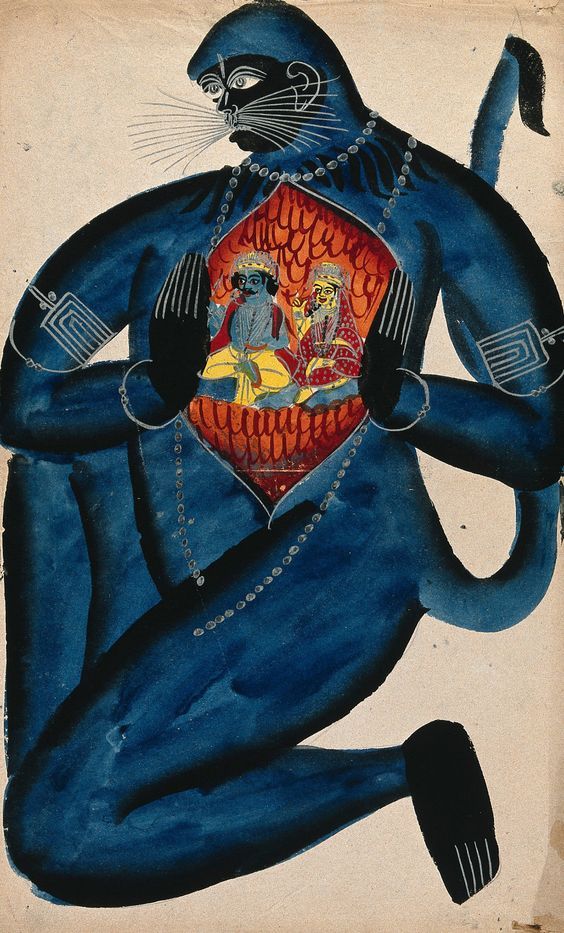
Unknown, Hanuman the monkey god, blessed with superhuman powers, rescues Rama (Vishnu) and his wife Sita from Ravana, king of Sri Lanka. When asked where he had hidden Rama and Sita, Hanuman replies 'In my heart'
watercolor, with pencil and silver ; sheet 45.8 x 28 cm
Kalighat painting is a school of painting in Kalighat, a small district in Calcutta. It is named after the Hindu goddess Kali. Kalighat painting originated from the folk art tradition of rural Bengal. The Patuas or picture makers had migrated from Bengal in the early nineteenth century. There are a range of subjects from religious imagery of Hindu gods, goddesses and stories to natural history, social types and proverbs. The range of materials used in drawing are pencil, watercolor, indian ink and silver paint
Welcome collection
676 notes
·
View notes
Text

American Indian activist, Vietnam War veteran, and protest folksinger, Peter LaFarge in Greenwich Village, August 1962
#ndn#indigenous#indigenous art#indigenous history#american indian movement#native american#native#folk singer#Peter la farge#swag#red power#Indian power#folk art
97 notes
·
View notes
Text

Still standing. 🪶🟧🟫💨
#first nations#american indian#native american#native people#native americans#First Nation#basquiat#peace pipe#standing rock#sioux city#sioux#crazy horse#sitting bull#Navajo#Apache#iroquois#lakota#south dakota#folk art#pow wow#teepee#water protectors#wounded knee#trail of tears#comanche#seminole#Foxwoods#red skins#mount rushmore#jean michel basquiat
15 notes
·
View notes
Text

#kshatriya#masculinity#masculine#antiquity#man#ancient#indian#vrindavan#shreekrishna#shreeram#hanuman#hinduism#painting#folk art#aesthetic#old paintings
12 notes
·
View notes
Link
Each region of India has its unique style of kalamkari indian folk art, madhubani indian folk art, types of indian folk art reflective of the local culture and traditions. For centuries, these folk artists have been passing down their skills from generation to generation, ensuring that this vibrant form of art continues to thrive.
0 notes
Text






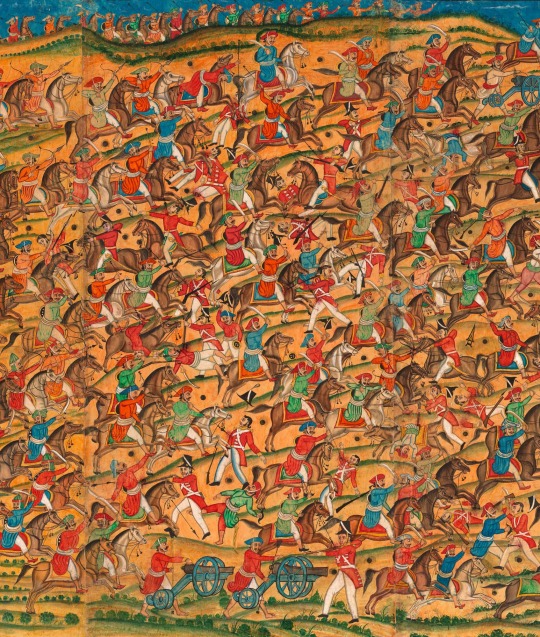

The Battle of Pollilur, India, Seringapatam, early 19th century.
Gouache on paper, within black rules, 10 large sheets of paper laid down on canvas.
8 feet x 32 feet
The Battle of Pollilur is undoubtedly one of the great masterpieces of the period: a panorama of one of the crucial turning points of Indian history, realised with extraordinary vivacity and energy that has few rivals in the art of the period. The painting extends over ten large sheets of paper, nearly thirty-two feet (978.5cm) long, and focuses in on the moment when the Company’s ammunition tumbril explodes, breaking the British square, while Tipu’s cavalry advances from left and right, “like waves of an angry sea,” according to the contemporary Mughal historian Ghulam Husain Khan. The pink-cheeked and rather effeminate-looking Company troops wait fearfully for the impact of the Mysore charge, as the gallant and thickly moustachioed Mysore lancers close in for the kill. To the right, the French commander Lally peers triumphantly through his telescope; but Haidar and Tipu look on majestically and impassively at their triumph, while Tipu, with magnificent sang-froid sniffs a single red rose as if on a pleasure outing to a garden to inspect his flowers.
Sotheby’s
27 notes
·
View notes
Text
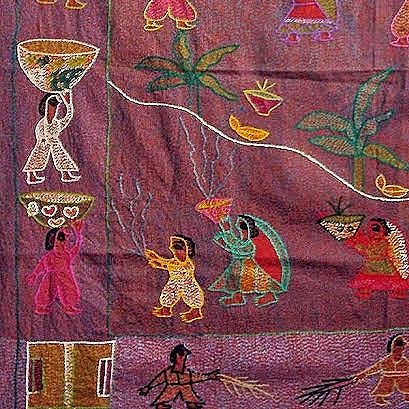
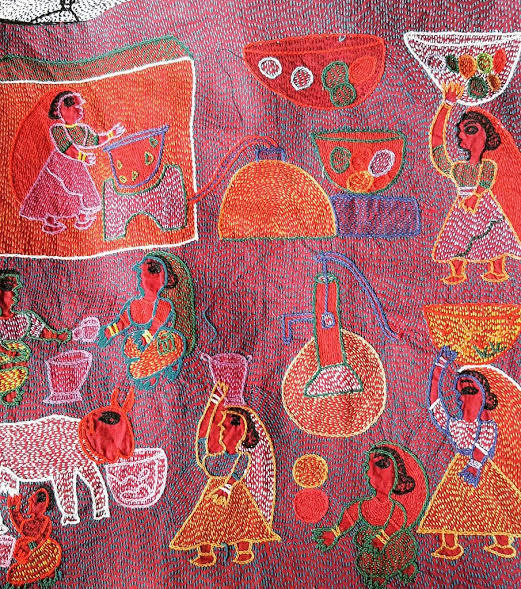

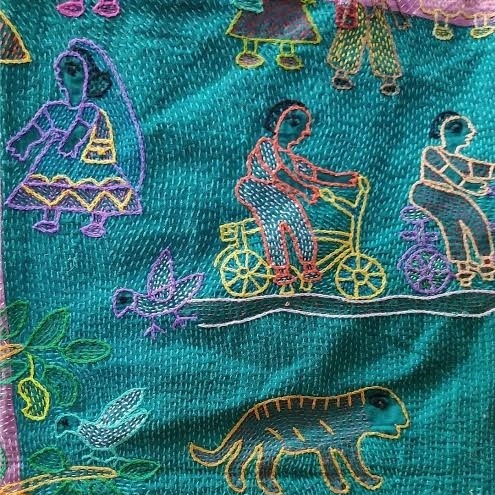
Sujani is a form of embroidery from Bihar in India. It is usually a quilt or bed spread, which was earlier made of old clothes, but is now generally made of easily available fabric with embroidery done with the most simple stitches with motifs narrating stories.
The word Sujani is a compound word of su meaning 'easy and facilitating' and jan meaning 'birth'. The earliest known traditional practice of making the embroidered Sujani quilt is traced to the 18th century. Its basic purpose was to give a soft cover to the newly born babies immediately after birth. It was then made with pieces of cloth in different colors derived from used saris and dhotis by sewing them together, adopting a simple running stitch. This process involved use of three or four patches of old saris or dhotis, fitted one over the other and then quilting them together using the thread that was also drawn from the discarded garments. Motifs expressing the mother's for her newborn child were sewn on the quilt, generally done with a chain stitch in dark color. The motifs sewn on the quilt represented sun and cloud, indicative of life-giving forces, fertility symbols, sacred animals, and mythical animals to protect against evil forces, and to attract blessings from the gods. Use of different shades of threads symbolized life's forces such as red, symbolic of blood and yellow denoting the sun. Sujani clothes and quilts are usually meant for winter wear.
1 / 2 / 3 / 4 / 5 / 6 / 7 / 8 / 9 | textile series
#textiles#ots#textile art#desi fashion#indian fashion#desi tumblr#desiblr#folk art#bihar#india#historical fashion
392 notes
·
View notes